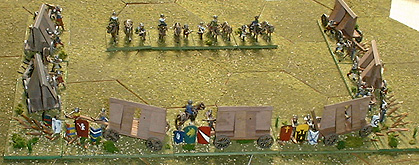
This page last modified: 2 March, 2002

A defensive wagon laager from the later half of the 15th century. Wagons were frequently used to protect an army when encamped. Specialist war-wagons like these were placed around the perimeter of the camp, while the ordinary supply wagons were arranged in a second circle inside this cordon as a second line of defence (not shown here).
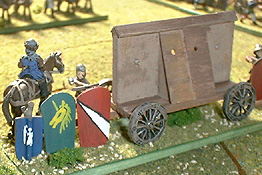
|
German armies continued to use war-wagons long after the Hussite wars, though their form was modified to what essentially amounted to a large wheeled mantlet. Such war-wagons are illustrated, amongst other things in Das Mittelalterliches Hausbuch, a wonderfully detailed contemporary manuscript. The central doors could be slid open and shut to allow the defenders to shoot with the minimum amount of exposure to the enemy. |
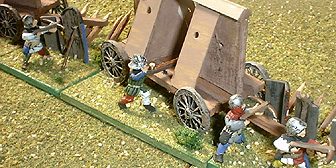
|
The use of handgun became more widespread after the Hussite wars, but it should be borne in mind that the crossbow was by far the more prevalent weapon until the very end of the century. Wagon defenders could use quite heavy gunpowder pieces, as shown here, resting on stocks in the fashion of later muskets. Pavises were gradually falling out of fashion, as they cut down on the bearer's manoeuvrability, but this was not a concern to those defending a wagon-laager. |
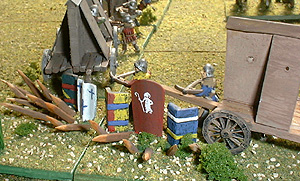
|
The wagon laager modelled here counts in all as 14 sections of temporary fortifications (TF) in the DBM rules, each wagon and associated paraphenalia takes up two sections. The corner sections shown here are "free" and do not count however; only sections with an internal frontage are costed, and only they can be attacked. The wheels are commercial white metal castings, otherwise the wagons themselves are entirely scratch-built. |
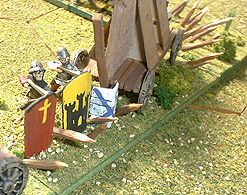
|
The large pavises are by Mirliton, the Italian manufacturer, as part of their 13th century Communal Italian range; such pavises were also extensively used by the Hussites. The figures are mostly by TableTop; I think a few may be Mikes Models or possibly Essex. |

Some of the models have detacheable pavies, etc. By swapping them with draught horse elements, two elements of TF can be converted in one WWg (O). When the army was on the march, such wagons were drawn up on either side of the marching column to protect it from flank attacks. They could also be utilised in a similar manner in battle, protecting the flanks of the infantry, while the cavalry could be deployed outside.
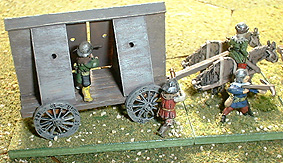
|
Although such mantlet-wagons were lighter than those used in the 1420s by the Hussites, they were still substantial affairs, requiring 4 horses to pull them. My models have only two however - four won't fit on a standard DBM WWg (O) base, and in any case, I didn't have enough model draught horses when I was building them to give them their full complement! |
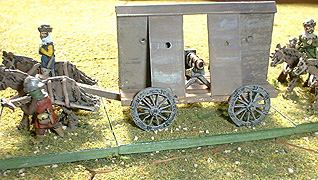
|
Wagons like this might even mount small artillery pieces called tarasbuchse (trestle-guns) from the way they were mounted. Indeed, it was they development of such small portable artillery pieces that spelled the demise of the war-wagon, since they were more than capable of smashing through the wooden planks protecting the defenders. |
Some old photos of war-wagons dating from earlier in the 15th century here.
Matt Haywood has an excellent site devoted to eastern European medieval warfare in which much information can be found relating to war-wagons.